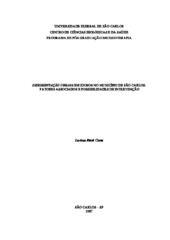Desorientação urbana em idosos no município de São Carlos: fatores associados e possibilidades de intervenção
Abstract
The world elderly population has gradually increased and, as a consequence, problems
associated with the aging process assume greater relevance. In Brazil, the population aging is
occurring in a sudden way, what makes difficult the regulation of the social and health
systems according to the new demands. Nowadays, one of the problems faced inside the
urban centers is related to the fact that the elderly people get lost, in the sense that they lose
themselves, living a kind of urban disorientation . This study aimed to characterize in what
conditions (environmental and personal ones) occurred the episodes of urban disorientation
among elderly people in the city of São Carlos, to identify possible factors which are
associated to this disorientation and to propose interventions preventing or minimizing
theirs impacts. People who took part in this study were 80 elders from both genders, with ages
between 60 and 98 year old (mean of 72 ± 10 years) living in the city of São Carlos SP. This
sample was divided into three groups: GROUP OF L CASES ( L from localização in
Portuguese, the same as localization in English), constituted by 15 elders who presented
difficulties in momentary localization; GROUP OF P CASES ( P from perder-se in
Portuguese, the same as to lose oneself in English), constituted by 30 elders who getting
lost and CONTROL GROUP, constituted by 35 elders who did not present urban
disorientation . The data were obtained through the application of questionnaires and of the
Mini-Mental State Examination . The hypothesis of the association between the investigated
variables and the urban disorientation was analyzed through the use of the Pearson s chisquare
test, (significance level a=0.05) and of the method of the Correspondence Analysis .
The characteristics of the places where the episodes of urban disorientation occurred were
analyzed through the use of descriptive statistical techniques. The percentages of elders who
obtained scores below the threshold in the examination of the Mini-Mental State
Examination were: 39% in the GROUP OF L CASES ; 36% in the GROUP OF P
CASES and 29% in the CONTROL GROUP. The results of the Pearson s chi-square test
indicated as variables associated to the urban disorientation the following items: psychiatric
disease, in the sample of institutionalized elders, and sleeping problem and diabetes in the
sample of non-institutionalized elders. In the Correspondence Analysis , the variables
associated to the urban disorientation were: to live in São Carlos for less than 20 years;
health state self-referred as poor or very poor; the use of psychoactive medicines and to suffer
from depression, besides the sleeping problems and the diabetes, which were also identified in
the Pearson s chi-square test. In relation to the environmental characteristics of the places
where the episodes of urban disorientation occurred, 20% of the elderly people involved in
the research reported its occurrence in places with signposting problems (the lack of
signposts, inappropriate public lighting and changes of the urban landscape); 40% informed
the non-existence of environmental problems and justified their disorientation by explaining
their difficulties in remembering the way they walked around, their momentary mental
confusion, their serious loss of memory, their sudden space disorientation, their changes of
mood and, finally, their recent coming to the city of São Carlos, and 40% did not remember
the characteristics of the place. From the results, proposals of interventions in the health
system and in its public policies were elaborated, with the intention of preventing and/or of
minimizing the impacts of the urban disorientation .
